Manager Tip: What Works to Encourage Scooping the Poop

Two things became clear over the last year: many people took to local trails to get outside, and many got a new 'pandemic puppy'.
This spring, trail managers have been struggling with a result of these pandemic changes: dog waste left along trails and parking areas. “We've received a number of reports from concerned hikers this year -- especially in early spring, when melting snow revealed a winter's worth of dog waste,” says Brett Thelen, Science Director of the Harris Center for Conservation Education in Hancock, NH. “We’re looking for new ways to communicate with trail users about why it’s vital they pack out their dog’s waste.”
Thankfully (or not?) they're not alone in needing new ways to encourage people to scoop up after their dogs. TrailFinder recently published Dog Waste Stewardship, outlining the science and benefits of picking up dog waste everywhere: not only in the city, but in your neighborhood, yard, favorite natural area or along the trail. Land managers are trying different ways to convince dog owners to carry-in, carry-out, but what really works?
We took a look at the research to find some suggestions:
- The availability of trash bins is likely to increase dog waste collection on streets and parks, but is less effective on trails (see Typhina and Yan, 2014).
- The availability of bags is an oft-cited barrier to cleaning up pet waste (what dog owner has not forgotten a bag on occasion?). Making bags available at trailheads – even without bins – will likely improve waste cleanup.
- The same authors noted that messages focused on the fact that no one wants to step in dog waste did affect dog owner behavior on rural trails. Emphasizing courtesy to neighbors was also an effective message for trail users.
- A study of park use in Kirkland WA showed that outreach and education can work. Un-scooped dog poop decreased by 80% as a result of a campaign to showcase the cumulative effect of dog waste. Over 3 weeks, park staff put up yellow flags on every un-scooped poop found in three parks, accompanied by signage and new pet waste removal stations (bins and bags).

- The Gallatin Valley Land Trust developed a creative set of signs to encourage scooping of dog waste around Bozeman, MT. Although land managers continue to report struggles with un-scooped poop, the signs have attracted interest from other land managers and are available to order by the designers.
- But how to get the stinky bag home? One blog post we read had some creative ideas (including a tailgate dumpster to install on your car), but the tried-and-true method is to cinch the bag under your windshield wiper and throw it away when you get home. Most wipers have just the right amount of tension.

- Several studies have shown that accountability is an important component to dog clean up behavior (see Alachua County Dog Waste Campaign). In recent years, many dog waste campaigns have included a pledge form - either digital, paper, or on social media - asking people to commit to cleaning up after their pet, every time. See this pledge form from Maryland. According to the Chesapeake Stormwater Network, "A pledge is a gentle but effective way to establish a commitment from the audience that can serve as a motivator and lead to lasting changes in behavior."
If you try out any of these tips, or find other creative cures for this pandemic of dog waste, let us know about it: nature.groupie@unh.edu or message us on social media @nature_groupie.
